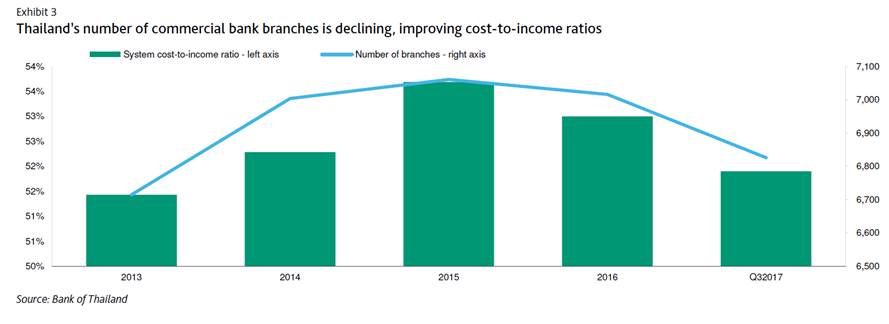No products in the basket.
- Latest
- Trending
Last week, the Bank of Thailand (BOT) published data showing a surge in the use of mobile and internet banking in Thailand.
Thai consumers’ rising preference for digital transactions is credit positive and demonstrates the initial success of Thai banks’ digital strategies, which eventually will allow banks to rationalize their branch networks and improve cost efficiency.
Over time, the widespread use of digital banking channels also will allow banks to increase revenue by expanding their product offerings via digital banking channels beyond current transactional products.

The volume of internet and mobile banking transactions continues to expand at a rapid pace (see Exhibit 1) as both internet and mobile penetration improve in Thailand.
Mobile and internet banking accounted for 33% of total payment transaction volume for the first nine months of 2017, a marked increase from 8% in 2010.
In value terms, mobile and internet banking accounted for THB23.4 trillion in the first nine months of 2017, a 22% compounded annual increase in value since 2010.
Thailand’s increased usage of digital banking channels since 2015 reflects banks’ increasing focus on digital strategies.
Kasikornbank Public Company Limited (KBank, Baa1 stable, baa21 ) in 2014 began investing around THB480 million annually to enhance its digital banking services. As of year-end 2017, KBank had 7.3 million users on its mobile banking channel, recording around 3 billion transactions during the year, a tenfold increase from 2014.
This year, Bank of Ayudhya (BAY, Baa1 stable, ba1) said that it would invest THB20 billion to develop its technology infrastructure and digital banking platform.
Siam Commercial Bank Public Company Limited (SCB, Baa1 stable, baa2) last year planned to invest THB40 billion to enhance its digital banking capability. We expect the volume of digital banking channel transactions to continue increasing.
The shift to online transactions provides Thai banks an opportunity to rationalize their branch networks, thereby extracting operational cost efficiencies.
Exhibit 3 shows the number of commercial bank branches decreasing to 6,826 as of 30 September 2017 from a peak of 7,061 branches as of 30 December 2015.
Concomitantly, the banks’ annualized cost-to-income ratios declined to less than 52% as of the end of September 2017 from 54% in 2015. In January, SCB announced plans to reduce its traditional branches to 400 from 1,153 by 2020, while BAY said it will transform half of its traditional branches into digital or hybrid-digital platforms. BAY expects its investment in IT to result in a 10%-15% decline in operating costs over the next three years.
Rebaca Tan, Analyst, Financial Institutions Group, Moody’s Investors Service
Make your Business everybody's business : publish your PR News on Siam News Network top reference news sites.








